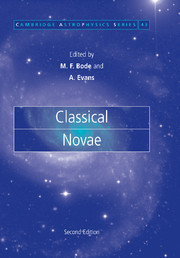Book contents
- Frontmatter
- Contents
- List of contributors
- Preface to the first edition
- Preface to the second edition
- List of symbols
- 1 Novae: an historical perspective
- 2 Properties of novae: an overview
- 3 The evolution of nova-producing binary stars
- 4 Thermonuclear processes
- 5 Nova atmospheres and winds
- 6 Observational mysteries and theoretical challenges for abundance studies
- 7 Radio emission from novae
- 8 Infrared studies of classical novae
- 9 Optical and ultraviolet evolution
- 10 X-ray emission from classical novae in outburst
- 11 Gamma-rays from classical novae
- 12 Resolved nebular remnants
- 13 Dust and molecules in nova environments
- 14 Extragalactic novae
- Object index
- Subject index
4 - Thermonuclear processes
Published online by Cambridge University Press: 10 October 2009
- Frontmatter
- Contents
- List of contributors
- Preface to the first edition
- Preface to the second edition
- List of symbols
- 1 Novae: an historical perspective
- 2 Properties of novae: an overview
- 3 The evolution of nova-producing binary stars
- 4 Thermonuclear processes
- 5 Nova atmospheres and winds
- 6 Observational mysteries and theoretical challenges for abundance studies
- 7 Radio emission from novae
- 8 Infrared studies of classical novae
- 9 Optical and ultraviolet evolution
- 10 X-ray emission from classical novae in outburst
- 11 Gamma-rays from classical novae
- 12 Resolved nebular remnants
- 13 Dust and molecules in nova environments
- 14 Extragalactic novae
- Object index
- Subject index
Summary
Introduction
The classical nova outburst is one consequence of the accretion of hydrogen-rich material onto a white dwarf (WD) in a close binary system. Over long periods of time the accreting material gradually forms a layer of fuel on the WD and the bottom of this layer is gradually compressed and heated by the strong surface gravity of the WD. Ultimately, the bottom of the layer becomes electron-degenerate. The degeneracy of the material then contains the explosion so that, once nuclear burning in the layer bottom reaches thermonuclear runaway (TNR) conditions, the temperatures in the nuclear burning region will exceed 108 K under almost all circumstances. As a direct result, a major fraction of the nuclei in the envelope capable of capturing a proton (C, N, O, Ne, Mg …) are transformed into β+-unstable nuclei, which limits nuclear energy generation on the dynamical time-scale of the runaway and yields distinctively non-solar CNO isotopic abundance ratios in the ejected gases.
Observations of the outburst show that a classical nova explosively ejects metal enriched gas and grains and this material is a source of heavy elements for the interstellar medium (ISM). The observed amount of metal enrichment demands that mixing of the accreted material with core material occur at some time during the evolution of the outburst.
- Type
- Chapter
- Information
- Classical Novae , pp. 77 - 101Publisher: Cambridge University PressPrint publication year: 2008
- 71
- Cited by



